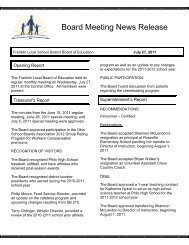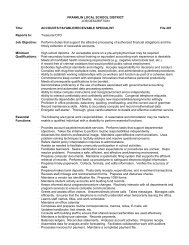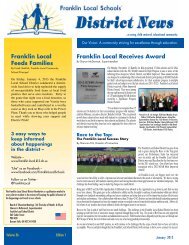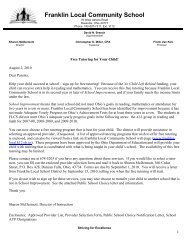FLSD - Ohio Improvement Process - Franklin Local School District
FLSD - Ohio Improvement Process - Franklin Local School District
FLSD - Ohio Improvement Process - Franklin Local School District
Create successful ePaper yourself
Turn your PDF publications into a flip-book with our unique Google optimized e-Paper software.
<strong>FLSD</strong> - <strong>Ohio</strong> <strong>Improvement</strong> <strong>Process</strong><br />
Teacher Based Teams (TBTs) complete the 5<br />
Step <strong>Process</strong> after each Common Assessment<br />
administration using the TBT 5 Step <strong>Process</strong><br />
Meeting Agenda and Minutes.<br />
Due to building principal:<br />
September 30, 2013<br />
January 13, 2014<br />
April 16, 2014<br />
Building Leadership Teams (BLTs) complete<br />
the 5 Step <strong>Process</strong> after each CA<br />
administration and completion of TBT 5 Step<br />
<strong>Process</strong> using the BLT 5 Step <strong>Process</strong><br />
Meeting Agenda and Minutes.<br />
BLT meeting dates must occur between:<br />
September 30, 2013 – October 21, 2013<br />
January 13, 2014 – January 27, 2014<br />
April 16, 2014 – April 27, 2014<br />
Principal or DLT building representative will<br />
be responsible for bringing BLT 5 Step<br />
<strong>Process</strong> Meeting Agenda and Minutes to DLT<br />
meetings. Principal or DLT building<br />
representative will report on building data<br />
relative to <strong>FLSD</strong> <strong>Ohio</strong> <strong>Improvement</strong> <strong>Process</strong><br />
Plan goals, adult implementation indicators<br />
and student implementation indicators.<br />
TT/DLT meeting dates for OIP purposes:<br />
October 22, 2013<br />
January 28, 2014<br />
April 28, 2014<br />
7/27/13
TBT 5 Step <strong>Process</strong> Meeting Agenda and Minutes<br />
Complete the following steps as a grade level/department team.<br />
See <strong>FLSD</strong> Testing Schedule for due dates.<br />
Grade Level/Department:<br />
Date:<br />
Step 1: Collect and Chart Data<br />
What data was collected<br />
(learning assessed) and<br />
how did all subgroups<br />
perform (report %<br />
proficient or above)?<br />
Step 2: Analyze Student Work Specific to the Data<br />
Which students or<br />
subgroups need<br />
additional time and<br />
support to achieve at or<br />
above proficient level?<br />
Note strengths,<br />
weaknesses, patterns,<br />
errors.<br />
Step 3: Establish Shared Expectations for Implementing Changes in the Classroom<br />
In what area(s) did our<br />
students struggle?<br />
What strategies were<br />
used by teammates<br />
whose students<br />
performed well?<br />
Step 4: Implement Changes Consistently Across All Classrooms<br />
What is our plan for<br />
intervention/enrichment<br />
(time/support) for<br />
improving results?<br />
Step 5: Collect, Chart and Analyze Pre/Post Data<br />
What instructional<br />
practices proved to be<br />
successful based on post<br />
assessment data? Next<br />
Steps?
BLT 5 Step <strong>Process</strong> Meeting Agenda and Minutes<br />
Using TBT data and the <strong>FLSD</strong> <strong>Ohio</strong> <strong>Improvement</strong> <strong>Process</strong> Plan,<br />
complete the following steps as a Building Leadership Team<br />
<strong>School</strong>: Facilitator: Date:<br />
What data was<br />
collected from Grade<br />
Levels/Departments?<br />
Report subgroup<br />
results for ELA and<br />
math.<br />
Step 1: Collect and Chart Adult Implementation and Student Performance Data<br />
Step 2: Analyze Adult Implementation and Student Performance Relative to the Data<br />
What does the data tell<br />
about students’<br />
learning and adult<br />
performance within<br />
and across grade levels,<br />
subject areas?<br />
Areas of growth or<br />
concern in student or<br />
adult performance?<br />
Step 3: Review and/or Refine Building Focused Action Steps Relative to the Data and Teacher Needs<br />
What changes need to<br />
occur to ensure desired<br />
results? Determine<br />
support or PD needs.<br />
Are there grade level or<br />
department practices<br />
worthy of replication?<br />
What action steps need<br />
to occur to ensure<br />
implementation of<br />
desired changes from<br />
Step 3? Feedback to<br />
TBTs, PD, Administrator<br />
observations, etc.<br />
Step 4: Establish Building-Wide Implementation and Monitoring Actions/Tasks for Step 3<br />
Step 5: Define Adult and Student Data for Review at Next Meeting<br />
What data will be<br />
reviewed at next<br />
meeting? What<br />
instructional practices<br />
or changes proved to<br />
be successful?
<strong>Franklin</strong> <strong>Local</strong> <strong>School</strong> <strong>District</strong> – 2012-2015 <strong>Ohio</strong> <strong>Improvement</strong> <strong>Process</strong> Plan<br />
Goal 1: Beginning with the 2012-13 school year through the 2014-15 school year, the Achievement and Graduation Gap Measure<br />
(Gap Closing) will be met or exceeded yearly in Reading proficiency, participation and graduation rate.<br />
Strategy 1A: Implement Formative Instructional Practices (FIP) as defined by the district’s Race to the Top Scope of Work in<br />
all K-12 classrooms.<br />
Adult Implementation Indicator:<br />
All K-12 teachers will implement Formative Instructional Practices (FIP).<br />
Student Implementation Indicator:<br />
All subgroups will meet or exceed the Achievement and Graduation Gap Measure (Gap Closing).<br />
Action Steps:<br />
1.a.1 Provide job-embedded high quality PD for Formative Instructional Practices (FIP).<br />
1.a.2 Implement and monitor Formative Instructional Practices (FIP) in all K-12 classrooms, including the <strong>Ohio</strong> 5-Step<br />
<strong>Process</strong>, the Marzano Framework and the Rigor and Relevance framework with a focus on:<br />
<br />
<br />
<br />
<br />
<br />
Clear learning goals and scales<br />
Effective feedback<br />
Collected and documented evidence of student learning<br />
Ownership of learning by students<br />
120 minutes of English Language Arts instruction in K-3 classrooms and 90 minutes in 4-5 classrooms.<br />
1.a.3 Evaluate the impact of Formative Instructional Practices on student Reading achievement, for all subgroup<br />
populations.<br />
Strategy 1B: Transition, in all Grades K-12, from the current Reading Academic Content Standards to the English/Language<br />
Arts Common Core.<br />
Actions Steps:<br />
1.b.1 Implement and monitor ELA Common Core as per the district’s Transition Schedule, including revised<br />
curriculum maps, common quarterly assessments and clear learning goals and scales.<br />
Page | 1
K-2 full transition 2012-13<br />
3-12 prep for transition 2012-13, full transition 2013-14<br />
1.b.2 Provide job-embedded high quality professional development for College and Career Ready (CCR) anchor<br />
standards for Reading in Math, Science and Social Studies classes, Grades 6-12 in:<br />
<br />
<br />
<br />
<br />
Key ideas and details<br />
Craft and Structure<br />
Integration of knowledge and ideas, and<br />
Range of reading and level of text complexity<br />
1.b.3 Provide community and parent involvement activities to increase College and Career Readiness awareness.<br />
1.b.4 Increase the amount of non-fiction reading that students will do in all core content classes to increase proficiency<br />
in informational text, with at least 50% non-fiction reading in K-5 ELA classrooms.<br />
1.b.5 Increase the amount of analytical writing (opinions, to explain, to inform), versus narrative writing, that students<br />
will do in all core content classes.<br />
Guidelines:<br />
Grades 3-5 65% (analytical)/35%(narrative)<br />
Grades 6-8 70%/30%<br />
Grades 9-12 80%/20%<br />
1.b.6 Provide job-embedded high-quality professional development for College and Career Ready (CCR) anchor<br />
standards for Writing in Math, Science and Social Studies, Grades 6-12 in:<br />
<br />
<br />
<br />
<br />
Text types and purposes,<br />
Production and distribution,<br />
Research to build and present knowledge, and<br />
Range of writing<br />
Goal 2: Beginning with the 2012-13 school year through the 2014-15 school year, the Achievement and Graduation Gap Measure<br />
(Gap Closing) will be met or exceeded yearly in Math proficiency, participation and graduation rate.<br />
Page | 2<br />
Strategy 2A: Implement Formative Instructional Practices (FIP) as defined by the district’s Race to the Top Scope of Work in<br />
all K-12 classrooms.
Adult Implementation Indicator:<br />
All K-12 teachers will implement Formative Instructional Practices (FIP).<br />
Student Implementation Indicator:<br />
All subgroups will meet or exceed the Achievement and Graduation Gap Measure (Gap Closing).<br />
Action Steps:<br />
2.a.1 Provide job-embedded high quality PD for Formative Instructional Practices (FIP).<br />
2.a.2 Implement and monitor Formative Instructional Practices (FIP) in all K-12 classrooms, including the <strong>Ohio</strong> 5-Step<br />
<strong>Process</strong>, the Marzano Framework and the Rigor and Relevance framework with a focus on:<br />
<br />
<br />
<br />
<br />
<br />
Clear learning goals and scales<br />
Effective feedback<br />
Collected and documented evidence of student learning<br />
Ownership of learning by students<br />
90 minutes of Math instruction in K-3 classrooms and 60 minutes in 4-5 classrooms.<br />
2.a.3 Evaluate the impact of Formative Instructional Practices on student Math achievement, for all subgroup<br />
populations.<br />
Strategy 2B: Transition, in all Grades K-12, from the current Math Academic Content Standards to the Math Common Core.<br />
Actions Steps:<br />
2.b.1 Implement and monitor Math Common Core, as per the district’s Transition Schedule, including revised<br />
curriculum maps, common quarterly assessments and clear learning goals and scales.<br />
K-2 full transition 2012-13<br />
3-12 prep for transition 2012-13, full transition 2013-14<br />
2.b.2 Provide job-embedded high quality professional development around the Math Common Core, to include:<br />
<br />
<br />
<br />
Critical areas of focus<br />
Integration of math into other content areas<br />
Standards of mathematical practices<br />
Page | 3<br />
2.b.3 Provide community and parent involvement activities to increase College and Career Readiness awareness.









